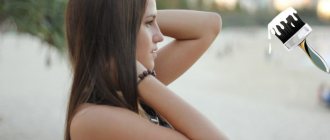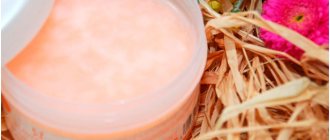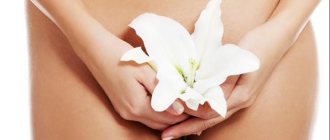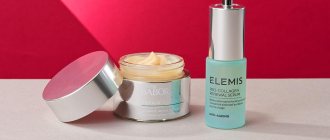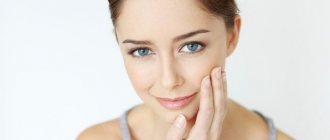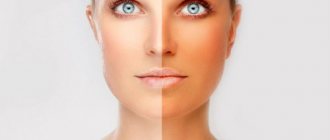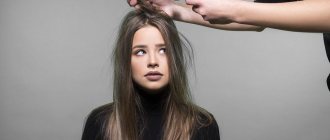It is not difficult to guess that the main task of sunscreens is to protect the skin from sun rays. However, “main” does not mean “only”! And the point is not to stop you from getting a caramel tan.
What specific problems will sunscreens save your skin from?
- Photoaging.
- Premature wrinkles.
- Dehydration and peeling.
- Loss of elasticity.
- Sunburn.
- Dark spots.
- Acne worsening.
- Photodermatitis (sun allergies).
- Melanoma.
- Spoiled vacation.
Russian quality system standard
The standard of the Russian quality system includes the requirements of TR CU 009/2011, as well as GOSTs regulating a number of indicators of perfumery and cosmetic products and methods of their research.
According to the Roskoshestvo standard, the SPF of a sunscreen must correspond to the declared one. The pH value should be in the range of 5–9. Water resistance (for waterproof sunscreens) – at least 50%.
The localization level of sunscreen production must be at least 35%.
The requirements of the Roskachestvo standard are voluntary and are not mandatory for the manufacturer, however, products that do not meet these requirements cannot qualify for the Russian Quality Mark.
Why are consumers hesitant to use sunscreen?
A Roskachestvo survey showed that 76% of Russians use sun creams with varying frequency. However, most have various concerns related to the use of sunscreen. In particular, consumers are concerned that:
- Sunscreens do not actually protect the skin from sun damage (the SPF claim is not true).
- The composition may contain harmful substances.
- Sunscreens block the body's access to vitamin D.
- Creams may cause skin irritation and allergies.
- Waterproof cream will actually wash off quickly.
How to use sunscreen
And finally, let’s outline a number of rules that are important to follow when using any means for sunbathing.
- First of all, it is important to determine your phototype and choose products that are suitable for it.
- There is no need to further cleanse your skin before using tanning product.
- Apply the product well and thoroughly to the face, chest, décolleté, and shoulders - these areas burn the fastest.
- Reapply the product every two hours.
- If the product is washed off with water, then it should be applied after each bath.
- The first dose of cream should be applied 15 minutes before going out into the sun.
- The more active the sun, the more powerful the cream should be.
- Oils should only be used on prepared or dark skin; they can be dangerous for fair skin.
- Read the composition and instructions for the product before purchasing, especially if you suffer from allergies.
How does sunlight affect the skin?
– From a practical point of view, we must talk about the impact on humans of two spectra of UV rays: medium-wave radiation (UVB) at a wavelength of 280–320 nm and long-wave radiation (UVA) at a wavelength of 320–400 nm.
UVB rays are responsible for causing burns, which can subsequently lead to skin cancer. However, UVA rays can cause much more harm. Penetrating into the dermis, these rays reduce its elasticity, firmness, and cause the appearance of wrinkles, folds, and age spots. 90% of type B rays are blocked by the upper layer of the skin (the stratum corneum of the epidermis), while 50–60% of UVA rays are able to penetrate deep into the skin, says dermatovenerologist, Doctor of Medical Sciences, Professor of the Department of Regenerative Medicine and Biomedical Technologies of Moscow State Medical University. them. A. I. Evdokimova Ekaterina Vasilyeva.
Extended exposure to the sun (a day at the beach, for example) damages skin cells. In response to this, melanocyte cells produce a pigment that protects the skin and at the same time colors it. Thus, tanning is a protective reaction of the skin to the aggressive effects of light.
Depending on the race, a person's skin contains different amounts of pigment. Thus, black people are the most invulnerable and less susceptible to melanoma than other inhabitants of the planet.
American dermatologist Thomas Fitzpatrick identified six phototypes:
- Celtic. People of this phototype have light, porcelain skin. They are very susceptible to sunburn.
- Nordic (or light European). This type of skin is also light in tone and is very sensitive to UV radiation. The risk of burning is still high, but not as high as in the previous case.
- Dark European. Although the skin is light, it is not too vulnerable to sunlight, it lends itself well to tanning, burns do not occur immediately, but only after prolonged exposure to the sun without protection (clothing, sun cream).
- Mediterranean. Light brown skin tone. The risk of sunburn is minimal. A tan always applies well to the skin.
- Indonesian. People with this skin phototype almost never get sunburned. The skin itself is brown.
- African American. People of this phototype have the darkest skin tone. The risk of sunburn is almost zero. Tanning only makes your skin darker.
How does suntan lotion work in the sun?
The cream, which is used for sunbathing, is used to obtain an even and beautiful skin tone and to avoid sunburn. That is, this means, in fact, like any other used for tanning, makes it possible to tan safely. Also, most formulations protect the dermis not only from burns, but also from premature aging and the appearance of unsightly spots - these processes are provoked by ultraviolet radiation. In general, tanning cream is a whole line of products that are used when sunbathing, but they can be both protective and increase the speed of tanning.
The history of the creation of sunscreen begins in ancient times. Moreover, previously all formulations were created only on the basis of plant ingredients. In Ancient Greece, olive oil was used, and in Egypt, rice and jasmine extracts were used.
Applying sunblock to skin
On a note! The very first artificial tanning cream was created in 1928. But it became possible to buy it only after almost 10 years.
It is interesting that creams with protection from UV rays were actively used by US military pilots in the 40s of the 20th century. Then the first UV blocker in principle appeared. And the SPF protection factor as a concept began to be used only in the 70s of the twentieth century thanks to the Swiss chemist Greiter.
Now almost any tanning product contains these same SPF filters, and when choosing a product you need to take into account the characteristics of your own dermis and the level of SPF protection. Any product with these filters creates a special screen on the skin, which allows you to be in the sun without fear for your skin and without fear of getting burned. This is how any sunscreen works.
The main functions of any tool:
- protection of skin from burns;
- improving the quality of tanning;
- nutrition of the dermis;
- protection of the epidermis from aging;
- preventing dehydration;
- protection against peeling.
What is SPF?
Sun Protection Factor, SPF (sun protection factor) – the strength of the protective effect against UVB radiation (spectrum B rays). The SPF index indicates how much of the rays the product allows through (provided it is applied correctly). For example, SPF 30 cream will let in 1/30 of the rays.
Many people mistakenly believe that SPF refers to the amount of time you can spend in the sun, but this is not true.
– The SPF 50 index means that when the cream is applied to the skin, it will withstand UV irradiation 50 times more intense. But this does not mean that, after applying the cream, you can stay under the sun 50 times longer than without the cream. After all, for example, in different regions the intensity of UV radiation can be different, and it can also change during the day. Skin phototype also influences. In the end, the cream can wear off, wash off and disintegrate under the influence of sunlight, and if it is applied unevenly, then the protection will be appropriate, explains Ekaterina Vasilyeva.
Does sunscreen interfere with vitamin D production?
Since any sunscreen allows a small amount of sunlight to pass through, there is no need to worry that the body does not produce vitamin D due to the cream. We also note that preventive vitamin intake is recommended for almost everyone (if you do not spend days under the sun), especially in the winter season. We tell you how and how much vitamin D to take HERE.
By the way! You need to protect not only your skin, but also your eyes. Read more about choosing good sunglasses and the dangers of too dark lenses HERE.
History of sunscreens
Until the middle of the last century, pale skin was in fashion. A tan was a sign of belonging to the lower class, because its representatives - peasants - worked 12 hours a day in an open field under the scorching sun. And people from high society tried in every possible way to hide their skin from the sun's rays, wearing closed clothes and wide-brimmed hats.
Until the beginning of the 20th century, tanning was not in fashion, so women wore closed clothes, hats and hid from the sun under an umbrella
In those days, herbal products were used to protect against the sun. For example, rice and jasmine extract, olive oil, and zinc oxide paste.
Later, the attitude towards tanning changed: workers with low wages had to work indoors in factories without the opportunity to relax at a resort. Then everyone began to strive to get a dark skin tone to prove their financial capabilities.
Thus, the need arose to protect the skin from sunburn and the effects of ultraviolet radiation. In the early 40s of the twentieth century, Red Vet Pet cream, which blocks ultraviolet radiation, appeared. It had a viscous texture and resembled red Vaseline.
And the world standard SPF (Sun Protection Factor), which determines the degree of protection of a cream, was introduced by the Swiss chemist Franz Greiter only in the 70s. Afterwards, the creams improved and became more and more popular.
The best sunscreens
The declared SPF corresponds to the actual one for almost all samples. Minor deviations were found in TM Floresan and Levrana (the actual SPF was 45.8 and 46.3 instead of 50, respectively).
Experts found five products with the highest actual SPF, ranging from 58 to 66. The most effective sunscreen is Librederm. It has the highest actual sun protection factor - 66. But do not rush to rejoice: the cream has a strong irritating effect on the skin (more on this below).
Vote
What sunscreen do you recommend?
Nivea Sun "Protection and Cool"
28.57 % ( 4 )
Vichy Capital Ideal Soleil
7.14 % ( 1 )
Darphin Soleil Plaisir
0.00 % ( 0 )
Lancaster Sun Beauty Care "Radiant tan"
0.00 % ( 0 )
La Roche-Posay Anthelios XL
7.14 % ( 1 )
L'Oreal Paris Sublime Sun Extra Protection
0.00 % ( 0 )
GARNIER Ambre Solaire Expert Protection
0.00 % ( 0 )
Garnier Ambre Solaire
21.43 % ( 3 )
Dry tanning oil Yves Rocher
21.43 % ( 3 )
Nivea Sun tanning oil spray SPF 6 with carotene
0.00 % ( 0 )
Emerald Bay Black Emerald
0.00 % ( 0 )
DEVOTED CREATIONS Limited Couture
0.00 % ( 0 )
Tan Master Dark Coco Nectar
7.14 % ( 1 )
Types of UV Filters: Pros and Cons
There are two types of components (filters) that protect the skin from the sun: physical and chemical.
Sunscreens with a physical filter
They contain metal salts - titanium and/or zinc (labeled as zinc oxide or titanium dioxide), which create a kind of shell covering the skin.
The containment shell is capable of:
- reflect and scatter sunlight;
- protect from rays purely mechanically (it prevents rays from reaching the skin - provided that the cream is applied in a sufficiently dense, uniform layer);
- According to some reports, it can also absorb ultraviolet light.
Pros of physical sun filters:
- can protect for several hours;
- have been sufficiently well studied, there are no questions about their safety.
Disadvantages of physical sun filters:
- they are usually quite dense in texture;
- can bleach the skin and leave white streaks.
For reference
To get rid of the whitening effect, some manufacturers are switching to micronized (finely ground) forms of powders or nanoparticles (in the composition they are labeled with the word “nano”). Such creams do not leave noticeable marks, but are more expensive.
Sunscreens with chemical filters
– Chemical filters are able to react with ultraviolet radiation and convert its energy into heat. This process occurs directly in the skin: the filters contained in cosmetics penetrate into the deeper layers of the epidermis and there they “meet” UV rays. Therefore, sunscreens and lotions do not begin to act immediately - it is better to apply them 15-20 minutes before going out into the sun, says Tatyana Vyugina,
.
The advantages of such filters are a lighter texture and the absence of noticeable white streaks.
Head of the Research Department of Roskachestvo Lyudmila Buslaeva
also explains that sometimes, when interacting with sunlight, chemical sunscreen filters can oxidize. Therefore, manufacturers, firstly, usually recommend renewing the cream regularly (about every two hours - provided that all this time you are actually in the sun and not indoors), and secondly, they add antioxidants to the composition that neutralize harmful action of oxidizing agents. These include some vitamins (for example, vitamin E), oils, etc. All the products studied (except TM Enough) contain several types of antioxidants.
There is controversy surrounding some of the ingredients in sunscreens about their safety. In 2022, the US Food and Drug Administration (FDA) released research showing that chemicals found in sunscreens enter the human body at potentially harmful levels. We are talking, in particular, about the following substances: avobenzone, oxybenzone, octocrylene and mexoril (or ecamsul). In repeated studies, homosalate, octisalate and octinoxate were added.
Some studies hypothesize that these components may negatively affect health - for example, on the reproductive or endocrine system. But so far, most experiments have been carried out only on rodents or in vitro, and the filters used by manufacturers are approved in almost all countries, including Europe and the USA, as well as the Russian Federation. In Appendix 5 of TR CU 09/2011, all of the above filters are listed as acceptable.
The list of prohibited substances in the cosmetics industry is constantly updated. If research on the dangers of a number of chemical filters were so convincing, then these filters would be banned in Russia, Europe, and other countries.
At the same time, the maximum permissible concentration is indicated for such filters, but in the Russian Federation there is currently no accredited method that would allow us to determine in what quantity a particular filter is contained in the cream.
There is no need to fear that the maximum permissible concentration in the cream will be exceeded.
“The content of sunscreen filters in the cream is determined by the recipe and usually does not exceed the indicators of TR CU 09/2011, since these products are quite expensive and it is not economically feasible to use them in larger quantities,” says Tatyana Vyugina
.
Often, creams use a combination of different types of filters - chemical and physical.
It is important that not all filters protect against both types of rays. For example, titanium dioxide protects against type B rays and only partially from type A rays. Zinc oxide protects against A and B rays. Usually the manufacturer takes this into account and adds several types of filters to the cream at once: some are more effective against rays A, others - against rays B, still others protect against both quite well. Mixing filters also makes the cream more pleasant in texture, which also makes it easier to apply evenly.
Lyudmila Buslaeva clarifies that there is no direct connection between the number of filters and the degree of protection: in some places there are only two sun protection components, in others there are five. The role is played not only by the number of filters in the composition, but also by their concentration and ratio in the composition (such nuances are usually a “company secret”).
Types of sunscreens
Previously, it was considered prestigious to have light, white skin, but now a tan is often perceived as a certain level of status, if we talk about European countries. This is an indicator that a person can afford to go on vacation to an expensive resort or has time to take care of himself by visiting a solarium. And in general, tanned skin looks smoother and more attractive, at least for Europeans.
On a note! In Asia, white skin is still considered the standard of beauty.
Products used to create a beautiful and safe tan can be produced in different forms. it may not necessarily be a cream. Let's see in what formats you can purchase the composition for sunbathing.
Table. Forms of tanning products.
| Form | Description |
| Cream | The classic and most common option, easy to apply, also improves the condition of the skin in general. Optimal for dry and sensitive dermis. As a rule, it does not leave a sticky residue and does not shine. Usually has high protection rates. Suitable for those who are afraid of burning or dream of an even tan. |
| Spray | A product that is convenient to apply, as it can simply be sprayed onto the skin. Usually has good water resistance. However, if you apply it unevenly, you can get a spotty tan. It often has an unpleasant, pungent odor. |
| Oil | Another classic that allows you to get rich, vibrant color. As a rule, it does not protect, but stimulates the appearance of tanning. Makes it possible to obtain a uniform shade. But it is consumed quickly and also leaves a greasy mark on the skin in most cases. |
| Lotion | An option that is convenient to apply and distribute evenly. The product has a light texture, suitable for both the body and face, but not for every skin in the latter case. Usually has good sun protection. |
Various sun protection products from Oriflame
On a note! There is also another form - fluid. This is a cross between lotion and cream. It is easy to apply, suitable for different skin types, but usually costs more.
By the way, all tanning cosmetics can be divided into two main categories. These are tanning products and formulations suitable for use in the sun. They cannot be replaced with each other, since the compositions have completely different functions and cannot be interchanged. There are also options for products that are used after sun exposure. They soothe and restore the dermis.
The level of sun protection should be optimal for the skin
Also, creams and other types of products can be divided into categories according to application areas:
- for the décolleté area, face, neck. It is best to take formulations with a high degree of protection and vitamins;
- for the legs and body - compositions that either protect or enhance the effect of the sun (depending on how well the skin tans here). The same composition is used for the body.
On a note! Tanning products can be moisturizing, waterproof, scented, and so on. In short, the products have many additional “functions,” and here you need to choose the best option for yourself, carefully reading what is written on the packaging and in the instructions for use.
But still, the main function of any product is to ensure the safety of sunbathing. Any tanning cream contains special filters that make it possible to protect the skin from exposure to UV rays. They can be divided into two types:
- physical or mineral, which create a special layer on the surface of the dermis that reflects rays. Does not penetrate the skin;
- chemical or organic - penetrate the epidermis, are able to absorb UV rays, converting them into thermal energy.
Advice! To obtain the maximum level of protection, it is recommended to use formulations with both types of filters.
Are sunscreens safe?
We have not identified any deviations in safety, in particular in the content of dangerous compounds and pathogens in the composition and in pH level. We looked for lead, mercury and arsenic in the samples, and in microbiology we checked the creams for the content of candida fungus, Pseudomonas aeruginosa, Staphylococcus aureus and Escherichia coli. We did not find heavy metals or the listed microorganisms in any of the samples.
All creams studied have a pH in the range of 5–8.2. The pH level of the skin is approximately 5.5. It is this indicator of acid-base balance that helps the skin perform its barrier functions, protecting the body from pathogenic microorganisms. The pH of the skin can change under the influence of various factors (both internal and external: sunlight, cosmetics, water, etc.). A change in the pH of the skin can lead to disruption of its functions, cause a feeling of dryness, etc. According to the Roskachestvo standard, the permissible and safe pH for the skin of sunscreens can range from 5 to 9. The highest pH - 8.2 - we recorded for creams and " Clearwin."
Stick
@shiseido The sun protection stick is very convenient to use in the city, when there is no time or opportunity to wash your hands, but you need to protect your face or shoulders from the sun here and now. One of the best in this category is the transparent Shiseido Clear Suncare Stick SPF 50+, which is based on an innovative formula with WetForce and HeatForce technologies, it enhances the sun protection properties of the product when the skin temperature rises or upon contact with water or sweat. Plus, the product also prevents dry skin and the appearance of wrinkles, age spots, acne and enlarged pores. By the way, this summer Shiseido and Roxy teamed up and released a set of stickers with the fashion brand’s recognizable tropical prints that you can use to decorate your favorite sunscreen products. Shiseido x Roxy sets have also appeared on sale - these are cosmetic bags with two product options: sunscreen and after-sun product, or instead of protection, a foundation with an SPF factor is presented.
Shiseido x Roxy Set: Face & Body Lotion SPF 50, After Sun Emulsion
Do not cause allergies, but may irritate the skin
All samples passed tests for sensitizing effects and mucosal irritation: the creams do not cause allergies and do not irritate the mucous membranes.
But only one cream out of 20 successfully passed the test for skin irritation. This is TM Clarins cream.
According to the CU TR, a cream is considered not capable of irritating the skin if it receives 0 points in tests. All creams, except Clarins, have scores greater than zero, but Garnier, Weis and Librederm have the maximum irritation score (1 point).
18 out of 20 TMs passed the test for general toxic effects. During the test, cell viability was assessed when exposed to the cream. TM Levrana and Siberian Wellness creams did not pass the test. They negatively affected the vital activity of microorganisms, and this indicates the ability of the cream components to influence living cells, including epithelial cells.
Note that we are not talking about a general acute toxic effect. The cream may cause skin irritation, but is unlikely to cause significant harm to health. It is interesting that these products contain natural ingredients (for example, Levrana cream contains calendula hydrolate, Siberian Wellness contains a lot of oils and calendula extract). Natural is often positioned as harmless and a priori useful, but in fact, natural does not always mean safe. At a minimum, natural components can cause irritation and allergies.
High and low sun protection
SPF with different values can be deciphered as follows:
- 1 ̶ such values indicate the absence of any protection, as when staying in the open sun;
- 2 ̶ suitable for cloudy weather, when the sun is not visible behind the clouds;
- 3 ̶ the degree of such protection is comparable to a white undershirt, baseball cap, or hat;
- 4 ̶ exactly the same effect as from openwork knitted light clothing;
- 5 ̶ the same protection is provided by almond oil applied to the body;
- 6 ̶ comparable to hiding in the shade under a tree, under an umbrella, etc.;
- 7 ̶ as if there is light denim on the body;
- 8 ̶ coconut and olive oil provide such protection;
- 10 ̶ similar protection is provided by thin clothing made of cotton or linen, as well as soybean oil;
- 12 ̶ like thin clothing, but in bright colors;
- 15 ̶ this is exactly the kind of marking that can be seen on most modern skin products: lipsticks, foundations, etc.;
- 20 ̶ this index must be chosen if a person is going to travel somewhere south of his permanent place of residence;
- 30 ̶ such protection is recommended for children, as well as for active sports in the sun;
- 40 ̶ increased degree of protection from solar radiation, the same as carrot seed oil;
- 50 is the maximum degree of protection, often used in anti-aging creams.
Expert opinion
Irina Kovaleva
Cosmetology expert
It is important to remember that when applying products with different degrees of sun protection, the indicators do not add up. That is, for example, if you sit under an umbrella in a denim shirt, you can still only get SPF 7.
A special feature of SPF filters is that they protect only from one type of solar radiation, thus protecting a person from burns. The other part of the radiation that reaches the skin is practically not reduced by SPF filters.
If you prefer the most reliable protection, preference should be given to products with a combined protective effect: SPF + UV- or PPD. The highest level of protection against solar radiation is provided by products with an SPF/PPD ratio of less than 3 with the PA index.
Which products are the most waterproof?
The most waterproof creams were Vilsen, Weis, Librederm, Sun Care, Garnier. The creams Ciel, Floresan, Levrana, A-Derma did not at all live up to the statements about water resistance in the labeling. The rest of the products are either moderately waterproof or not waterproof, but at the same time they are not positioned as intended for swimming (they do not have a water resistance mark in the labeling).
– To make the sunscreen waterproof, acrylates and polymers are added to the composition (look for the letters PVP or VP, for example: VP/hexadecene copolymer, ammonium acryloyldimethyltaurate/VP copolymer, VP/eicosene copolymer). It also forms a methyl abietate film, providing the cream with water resistance and increasing SPF, explains Ekaterina Vasilyeva.
The best tanning products: a review of popular products
| Photo | Name | Rating | Price | |||
| The best tanning creams for the sun | ||||||
| #1 | Nivea Sun "Protection and Cool" | ⭐ 4.95 / 5 4 - votes | Find out the price | |||
| #2 | Vichy Capital Ideal Soleil | ⭐ 4.9 / 5 1 - voice | Find out the price | |||
| #3 | Darphin Soleil Plaisir | ⭐ 4.85 / 5 | Find out the price | |||
| #4 | Lancaster Sun Beauty Care "Radiant tan" | ⭐ 4.8 / 5 | Find out the price | |||
| #5 | La Roche-Posay Anthelios XL | ⭐ 4.75 / 5 1 - voice | Find out the price | |||
| #6 | L'Oreal Paris Sublime Sun Extra Protection | ⭐ 4.7 / 5 | Find out the price | |||
| #7 | GARNIER Ambre Solaire Expert Protection | ⭐ 4.65 / 5 | Find out the price | |||
| The best tanning oils | ||||||
| #1 | Garnier Ambre Solaire | ⭐ 4.95 / 5 3 - votes | Find out the price | |||
| #2 | Dry tanning oil Yves Rocher | ⭐ 4.9 / 5 3 - votes | Find out the price | |||
| #3 | Nivea Sun tanning oil spray SPF 6 with carotene | ⭐ 4.85 / 5 | Find out the price | |||
| The best tanning creams for solariums | ||||||
| #1 | Emerald Bay Black Emerald | ⭐ 4.95 / 5 | Find out the price | |||
| #2 | DEVOTED CREATIONS Limited Couture | ⭐ 4.9 / 5 | Find out the price | |||
| #3 | Tan Master Dark Coco Nectar | ⭐ 4.85 / 5 1 - voice | Find out the price | |||
| #4 | Australian Gold Accelerator Extreme | ⭐ 4.8 / 5 1 - voice | Find out the price | |||
What sunscreen do you recommend?
Take the survey
This list includes several options for products that are used to create a beautiful tan and safe sunbathing. All drugs listed below were selected based on customer ratings and reviews left by them on popular online resources. Our editors believe that this rating can be used to guide you when choosing a product. But you should not accept it as the only true and correct one. If desired, the user can choose a completely different version of tanning cream.
Labeling: Mandatory Warnings and False Promises
We often see big claims on packaging that are misleading. The Roskachestvo standard defines a number of deliberately false statements that are not supported by any facts.
What inscriptions should not be on the label?
- “100% UV protection.” No cream provides 100% protection. In addition, such information can give a person false confidence that he is completely protected, which is why he will neglect other protective measures: covering open areas of the body with clothes, staying in the shade, etc.).
- "All day protection." Even if the composition contains more “long-lasting” physical filters, which, unlike chemical ones, do not disintegrate under the influence of the sun, you can still accidentally wash off or wipe off part of the cream during the day.
It’s good that in our research, not a single one contained such deliberately false statements.
What inscriptions, on the contrary, should be on the label?
The labeling must contain some form of warning that has the following meaning:
- Do not stay in the sun for too long, even if using sunscreen.
- Reducing the amount of cream or uneven distribution will significantly reduce the level of protection.
- Reapplying of the cream is required (for example, after sweating, swimming or drying with a towel).
None of the listed warnings are on the label of creams TM Sun Care, Ciel, Clearvin, Alpika, Siberian Wellness, Cosmia.
On the contrary, all the necessary warnings are contained only in the labeling of TM Garnier products.
In other cases, the requirements of the Roskachestvo standard for labeling are only partially met (some necessary recommendations are listed, but not all).
The best tanning oils
Most users note that to get a quick and intense even tan, you need to purchase oil, not cream. As a rule, these products do not have sunscreen, but, on the contrary, tan-attracting properties. However, they protect the skin from burns to some extent, help eliminate the risk of unwanted pigmentation, and make it possible to tan really quickly. Let's see which oils users use most often.
No. 3 – Nivea Sun tanning oil spray SPF 6 with carotene
Nivea Sun tanning oil spray SPF 6 with carotene
This oil with a low level of protection against UV rays is ideal for creating an even, beautiful tan in a short time. True, it is only suitable for dark skin.
The level of protection of the product is low and is only 6 SPF, but this is a normal indicator, considering that it is used specifically for tanning. This is a waterproof option that will not wash off when swimming. Additionally, the product moisturizes the skin, making it softer and softer. It contains carotene for a brighter tan and vitamin E. The tan really sticks faster and turns out even and neat.
Users write that this product really allows you to become bronze faster, but it stains your clothes a lot. Also, the tan itself is washed off quite quickly, but while it is fresh, it has a beautiful shade. Consumption is economical. In general, it is an inexpensive and effective product with its drawbacks.
pros
- it's inexpensive
- allows you to tan quickly
- provides a beautiful tan
- good composition
- waterproof
- protects against UV rays
Minuses
- stains clothes
- the tan washes off quickly
Prices for Nivea Sun tanning oil spray SPF 6 with carotene
Nivea Sun tanning oil spray SPF 6 with carotene
No. 2 – Dry tanning oil Yves Rocher
Yves Rocher Dry Tanning Oil
This is a convenient option for a product that will help you tan quickly and beautifully. The delicious smell, high efficiency and reasonable price allowed the composition to find a large number of admirers.
The product is perfectly absorbed, and not only helps to attract the tan to the skin, but also makes it soft and tender. It is best to apply only to dark or already tanned skin to avoid getting burned. The composition also helps to preserve the resulting color for a long time. The oil is easy to apply; it has a special spray dispenser. Absorbs quickly without leaving any unpleasant marks.
Users note that this is an effective tool that they do not want to change. A low protection factor is not a hindrance, since otherwise the oil does its job perfectly. You just shouldn’t stay under the scorching rays for a long time to avoid getting burned.
pros
- it's inexpensive
- does not stain clothes
- convenient to use
- gives an even and beautiful tan
- absorbs quickly
- cares for the dermis
Minuses
- low level of protection
Prices for dry tanning oil Yves Rocher
Dry tanning oil Yves Rocher
No. 1 – Garnier Ambre Solaire
Garnier Ambre Solaire oil
A product that is recommended for dark-skinned people to get a beautiful tan. It fits perfectly on the skin and allows you to tan quickly.
Contains shea butter, which helps the skin tan faster and more evenly. Also, due to a good set of ingredients, the oil additionally cares for the skin, making it smooth and soft. For fair skin, it is suitable if you first “accustom” the dermis to the sun, that is, it is recommended to smear with oil only three days after the start of sunbathing. The main disadvantage is that it washes off with water, so after swimming you need to reapply the layer.
Users write that the oil is easy and smooth to apply, has a low cost and is affordable even for the most budget-conscious. But it stains things, and can also be felt on the skin in extremely hot weather. The level of protection is quite high - 20 SPF.
pros
- cheap
- high level of protection
- easy to apply
- good composition
- suitable for light skin
- smells nice
Minuses
- gets things dirty
- feels uncomfortable on the skin in hot weather
Prices for Garnier Ambre Solaire oil
Garnier Ambre Solaire oil
Reviews of Garnier Ambre Solaire oil
The Roskachestvo effect: manufacturers' reaction
We sent a notification to all manufacturers (or importers) about the study and the identified deviations; all recipients confirmed receipt of the letter.
JSC MKF Rassvet (manufacturer of Sun Care cream) responded that a number of corrective measures were taken to control production and the products were submitted for additional testing. Comments regarding the warnings in the text on the tube were also taken into account (there are no instructions that the cream should be applied tightly, evenly, or that prolonged exposure to the sun should be avoided). A new layout with corrected markings was sent to print.
Manufacturers of creams, Sol bianca, also reported that they are ready to urgently add additional information to product packaging.
A representative of the Auchan retail chain reported that due to the results of the study, TM Cosmia cream was removed from sale in all stores of the chain.
